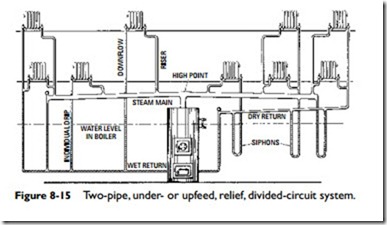Two-Pipe Steam Heating Systems
In two-pipe systems, separate pipes are provided for the steam and the condensate; hence they may be of smaller size than in one-pipe systems, where a single pipe must take care of both steam and condensate. Various piping arrangements are used in two-pipe systems (e.g., circuit, divided-circuit, and loop) to best meet the requirements of the building. Steam is supplied to the heat-emitting units through risers, and the condensate is returned through downflow or drip pipes.
Two-Pipe, Divided-Circuit System
A two-pipe, divided-circuit system is shown in Figure 8-15. In this two-pipe system, steam passes from the boiler at the high point to the mains, along which risers bring the steam to the heat-emitting
units. From the opposite side of each unit is connected a drop or drip pipe. Figure 8-15 shows a wet return on the left side and a dry return on the right side.
In the wet return, the condensate is returned to the boiler by means of individual drips provided at each connection. There is a dif- ferent arrangement for the dry return. The drip pipe from each heat- emitting unit terminates in a loop or siphon, which is tapped to the dry return. In operation, the condensate gradually fills the siphons and flows over into the dry return, passing into the boiler drip pipe.
A two-pipe system should also be provided with a check valve so placed as to allow water to pass into the boiler but prevent undue outflow. Under certain conditions, this prevents the water in the boiler from being driven out into the return system by the boiler pressure. The disadvantage of a check valve is that it sometimes gets stuck, a problem that can interfere with the operation of the system. An equalizing pipe with a Hartford connection loop may be used in place of a check valve to avoid this situation (see Hartford Return Connection in this chapter).
